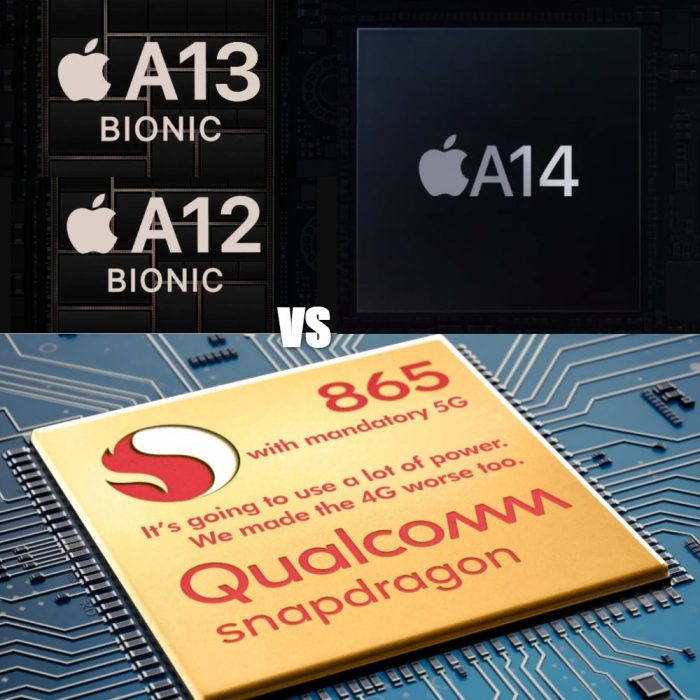Recently, Apple took its way to announce new products in its annual event on September 15, 2020. Most of us were expecting a new iPhone series to be launched, but the company only announced a new iPad. But at the same time, we came to know a new chipset named Apple A14 Bionic powering the new iPad. The thing is that the same chipset will be used in the new iPhone 12 series, which can be announced anytime soon within a month or so. Hence, we have a fair idea of how powerful will be the 2020 iPhone series.
Due to the Covid19 pandemic, there is some delay in arriving Apple’s new iPhone lineup. Moving towards the A14 Bionic chipset, it is an improved version of the A13 Bionic used on last year’s iPhone 11 series. In this article, we will be making a full in-depth comparison between these chipsets. We have also included the Snapdragon 865 and 865 Plus for a fair comparison.
Recommended: Apple A13 Bionic vs. A12 vs Kirin 990 5G vs. Snapdragon 855 Plus
Remember that Qualcomm is the industry leader and powering most of the latest flagship Android smartphone. I know most of you are curious to make a comparison between Android vs. iPhone. So, it makes sense. Without any further ado, let’s get started Apple A14 Bionic vs. A13 vs. A12 vs. Snapdragon 865/Plus comparison!
Comparison: Apple A14 Bionic vs. A13 vs. A12 vs. Snapdragon 865/Plus
CPU & Performance
Starting with the new Apple A14 Bionic, it uses the latest 5nm fabrication process, making it the first mobile platform to use such technology. Apple A13 and Snapdragon 865 use the older TSMS’s 7nm+ fabrication, while the A12 bionic built on the two-year 7nm process.

The smaller chip size means better power efficiency. As long as the SoC is consuming less power, there will be less heating issues. Hence, it will get a boost in performance. Undoubtedly, The Apple A14 is the most power-efficient chipset on the list. Therefore, we can expect better battery life. Last year’s 7nm+ performs better than the 7nm fabrication used on A12 Bionic. But the differences are minimal. Meanwhile, the latest 5nm process is the real upgrade over 7nm, making the A14 bionic a balanced chip with great power efficiency.
Heading towards the CPU, however, the company didn’t reveal the exact specifications. But it is a new generation Hexa-core CPU. The company claims that Apple A14 Bionic produces 40% better CPU performance compared to A12. Nevertheless, Apple compared it with two years older chip, but we already know that A13 Bionic was 20% faster than the A12. We can expect 16-17% better CPU performance on the 2020 chip.
On the other hand, Snapdragon 865 Plus comes with a tri-cluster octa-core CPU with max. 3.1GHz clock speed. The standard Snapdragon 865 uses the 2.84GHz clock speed for performance cores. Qualcomm claims 10% better performance on the Plus variant.
When compared with Apple A14 Bionic, Qualcomm seems better in terms of specifications. But we already know that Apple chipsets are highly optimized for its products. So, they produce better real-world performance. Qualcomm being chipset manufacturers, it can’t optimize its chipsets for different manufacturers according to their demand. Even last year’s A13 Bionic delivers better performance in some instances. The Apple A14 Bionic is a clear winner in this section, followed by A13 Bionic, Snapdragon 865/Plus, and A12.
GPU
The new Apple A14 Bionic comes with the latest Apple-designed quad-core GPU, which is 30% faster than the A12. Similar to the CPU, GPU comparison also takes it to 2-year-old A12 Bionic.
Knowing that A13 was 20% faster than A12 in the GPU department, we can expect an 8-10% batter GPU performance with the latest 2020 Apple SoC. However, GPU improvement isn’t that big, at least on papers, but the chipsets designed by Apple are already doing very well in the industry. Last year’s iPhone 11 series is best known for its highly optimized graphics, leading to a seamless smooth gaming experience.
The Snapdragon 865 series accumulates Adreno 650 GPU. On paper, GPU looks similar on both Snapdragon 865 plus variant. But the company claims a 10% GPU performance boost for Snapdragon 865 Plus. In comparison to the Apple Bionic lineup, Snapdragon 865 looks better specs-wise. But similar to the CPU, Apple GPU is very well optimized for Apple products. So, it does a better job in real-world performance.
Also Read: Snapdragon 865 Plus vs. 865 vs. Apple A13 Bionic
Artificial Intelligence
Artificial Intelligence is slowly becoming the dominant player in the tech industry. This is the criteria where we get to know how intelligence the specific product is. Moreover, it is the prime motive of our modern era smartphones. Last year, we saw some significant improvements on the A13 chip over A12. But Apple A14 Bionic takes it to the next level.
Thanks to the 5nm fabrication process, A14 managed to seize 11.8 billion transistors on a smaller form factor than 8.5 billion found on A13. Transistors are electronic on/off switches to control electrical power, just like neurons found in the human brain. It is a remarkable improvement for Apple to make it a more power-efficient chip using AI technology. However, Qualcomm didn’t specify the transistor count for Snapdragon 865 series. To make the chip more power-efficient, the company uses Hexagon Tensor Accelerator.
The Apple A14 Bionic processor launches with the latest 16-cores Neural Engine, which is as much as twice powerful than the last generation. The apple claims to perform 11 trillion tasks per second compared to six trillion for the A13 Bionic. There is a significant improvement by Apple in the AI department because everyone knows AI is the tech industry’s future.
Qualcomm has its own neural system. The company calls it Ultra-intuitive AI. It is a fifth-generation AI Engine with almost 100% faster than its predecessor. The Snapdragon 865 series uses AI technologies such as Vector eXtensions, Sensing Hub, and Scalar Accelerator controlled by Hexagon 698 Processor. There is no direct comparison between Apple and Qualcomm because both use different technologies to achieve various tasks.
Antutu-Geekbench Benchmark Scores
Antutu Scores (v8)

Apple A14 Bionic being q latest chip, we don’t have Antutu scores available yet. Further, the Apple A13 Bionic scores 5,16,681 points, followed by its predecessor A12 with 4,53,851 points. This is the criteria where Snapdragon has blown away the Apple processors. Snapdragon 865 Plus is the winner with whopping 6,67,253 points. The Snapdragon 865 follows with 5,74,985 points on Antutu v8.
Geekbench 5 Scores

The A14 Bionic] has no official Geekbench 5 scores available. But thanks to the leaked data, which shows some estimates of how it will perform. According to A14 leaked benchmarks, it scores 1,658 points in single-core and 4642 points in multi-core Geekbench 5 results. The Apple A13 follows it with 1,326 points in single-core and 3,321 points in multi-core results. The Snapdragon 865 Plus scores 973 points in single-core core and 3346 points in multi-core.
Vanilla Snapdragon 865 has 923 points in single-core and 3,267 points in multi-core Geekbench 5 results. Apple A12 Bionic is in the last position with 1,109 points in single-core and 2621 points in multi-core results. Apple chipsets seem to be more powerful, based on Geekbench scores. Even two years old Apple A12 Bionic beats the Snapdragon 865 series in single-core results but outranked in multi-core scores. We are still waiting for the official results of Apple A14, which will give us a distinct look at its capabilities.
Conclusion – Which One is Better?
Overall, the Apple A14 Bionic chipset comes with significant improvements over its predecessor A13 Bionic. However, there are minimal reforms in the GPU department, but the latest 5nm fabrication makes it the smartphone industry’s king. There is no doubt that TSMS’s 5nm process is way more power-efficient than the older 7nm+ used on Snapdragon 865 series and last year’s Apple A13 Bionic. The Apple A14 Bionic stands tall against its competition in most of the criteria, whether it is CPU or Artificial Intelligence.
On paper, Snapdragon 865 and 865 Plus look impressive. But when it comes to real-world performance, Apple snatches its position from Qualcomm. As we have already discussed, Apple works more on optimization than supplying out of the world specification. From my point of view, that is a more practical approach. Another key advantage for Apple is that it manufactures chips for its ecosystem. In contrast, Qualcomm is a third-party vendor for smartphone manufacturers.
Suppose that if other manufacturers used Apple chipsets, Qualcomm was definitely the undisputed winner because it delivers better specifications. Optimizations are the key reason that makes the Apple winner. But, better specs are the primary reason for Snapdragon to score more on Antutu. Overall, Apple devices convey a more practical experience rather than offering specifications. What are your thoughts? Do let’s know in below comment section!
Final Winner: Apple A14 Bionic > A13 Bionic > Snapdragon 865+ > Snapdragon 865



How can any tech site still compare Antutu benchmarks?
Android and iOS results are not comparable anymore as benchmarks are since version 8 different.
Hi Frantisek,
We agree with your point. But people love to see Antutu comparison. That is why we have included, otherwise, it doesn’t make any sense when it comes to real-world usage. Moreover, Antutu scores are good to know how powerful a processor is. But Apple more focuses on optimizations, that is why fewer scores, but the overall experience is smooth enough.